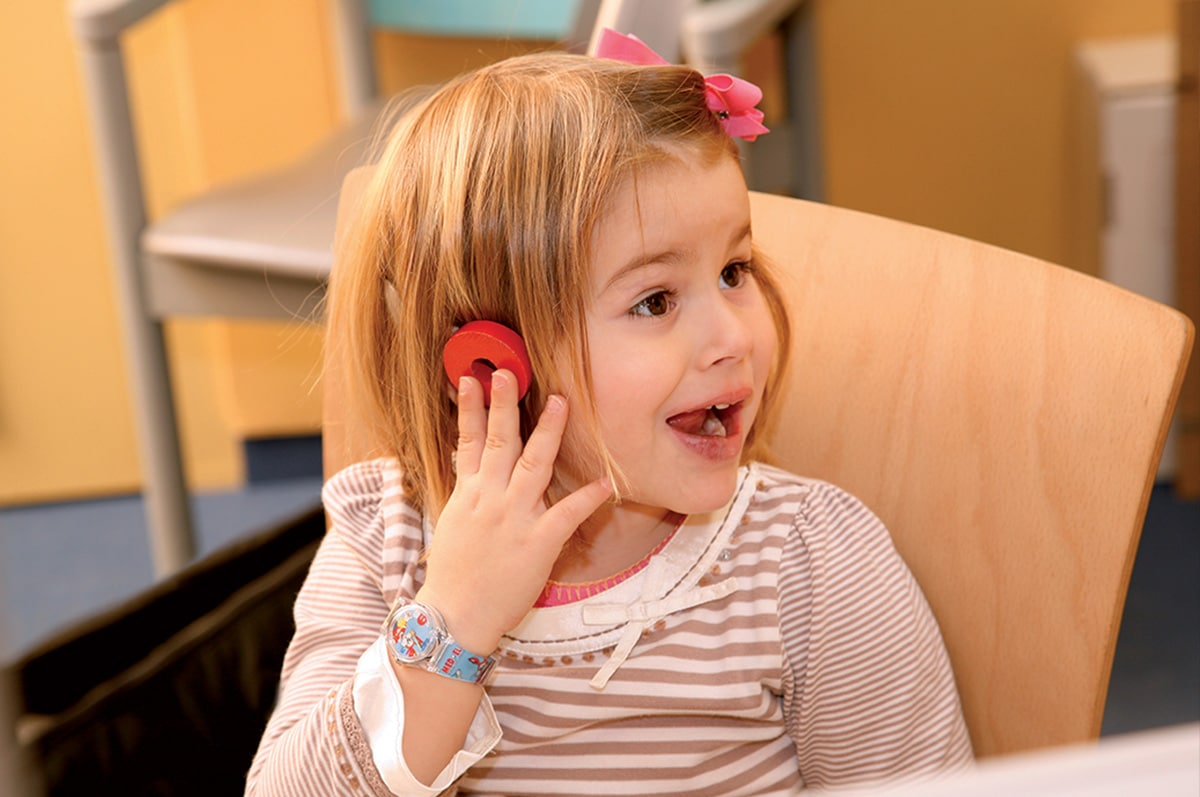Listening Games: 5 Ways to Help Your Child Detect Sounds

What’s the best way to have good listening and speaking skills? It’s to have a solid foundation built on noticing and recognizing sounds. Playing listening games is a good way to develop these basic skills.
This is especially true for young cochlear implant recipients, like those who are pre-lingually deaf or did not have much experience with recognizing sounds before receiving their implant. Playing listening games gives your child experience detecting a wide variety of sounds in an interactive and fun way. Then, you can help your child build his or her listening skills.
So, here are five games that you can use to help your child learn to detect and recognize sounds:
Listening Games 1: Go for a “Listening Walk” Inside the House
This game can be played inside of your house, and you don’t need any special toys or tools. Just use the toys or household appliances that you’ve already got!
- Walk around your house and look for appliances that make sounds, like the microwave, refrigerator, vacuum cleaner, washing machine, or a flushing toilet.
- Then, walk around the house with your child. When you’re near an object that you’ve picked, stop and say “listen!” to prepare your child for the sound.
- Now turn the object on so that it makes a noise.
- Show your child that you are listening by pointing to your ear, and then smile and nod. You can also say “I hear that!” and use your voice to copy the sound.
- Once you’ve had some fun with this sound, then go on to the next one.
Listening Games 2: Go for a “Listening Walk” Outside the House
This is like the game above but instead of playing it in the house, where your child might be familiar with the sounds, this version adds the surprise of new or unknown sounds.
- Walk around the neighborhood and find things that make sounds. This can be either pre-planned, like going to a busy road where you know there will be cars, or unplanned like if there’s an airplane that suddenly flies overhead.
- Then, walk around outdoors with your child—it could be through a park, or just down the street. When you’re near an object that makes noise, stop and say “listen!”
- Show your child that you are listening by pointing to your ear, and then smile and nod. You can also say “I hear that!” and use your voice to copy the sound.
- Once you’ve had some fun with this sound, then go on to the next one.
- It can be fun to take photos of all the different noise-making things that you see, so that you can use these to look at and copy the noises that were made.
Listening Games 3: The “Find the Keys” Game
This is an easy game that needs only a set of keys and two identical, opaque, containers.
- Each time you put your keys away, put them into one of the containers. Cover both the containers with their respective lid, and don’t let your child see which one has the key!
- Then, as you leave the house grab both containers and start the game.
- Ask your child, “can you hear where the keys are?”
- Then shake one of the containers. If the keys are in this one it will make a sound. If this is the case, smile and nod your head while saying “Yay!”
- If the container is empty, look sad and shake your head while saying “No” and shake the other container which has the keys in (see step 4).
- By playing this game each time you leave the house, your child will get lots of practice and might soon be able to hear the keys all by himself or herself.
Listening Games 4: The Wake Up Game
Here’s a quick game that you can play, and all you need is two adults and a large blanket.
- The set-up, showing your child how to play:
- Have the first adult go underneath the blanket, while the other adult says “Shhh, now it’s bedtime.”
- After they’re under the blanket, wait quietly for a short while.
- Then, have the second adult suddenly call “Wake up!” in a loud voice.
- Once the second adult calls “Wake up!”, the first adult should jump out from under the blanket and say “Hi!” or “Good morning!”
- After you’ve done this once or twice, let your child have a turn under the blanket.
- Have the child go underneath the blanket with one adult, while another adult says “Shhh, now it’s bedtime.”
- After they’re under the blanket, wait quietly for a short while. The adult under the blanket should prompt the child to listen for a sound.
- Then, have one suddenly call “Wake up!” in a loud voice.
- If the child hears the “Wake up!” call, he or she should jump out from under the blanket and say “Hi!” or “Good morning!”
Listening Games 5: The Alarm Clock Game
For this, all you need is a small alarm clock or a phone with an alarm.
- Set the alarm to go off in around 30 seconds.
- Have your child close his or her eyes, then hide the alarm somewhere nearby.
- When the alarm goes off, say “Listen!”
- Show your child that you are listening by pointing to your ear, and then smile and nod. You can also say “I hear that!” and use your voice to copy the alarm.
- Have your child use his or her hearing to recognize that the alarm is making a sound.
Do you have any more requests for specific tips or listening games? Let us know!
Thanks for your message. We will reply as soon as possible.
Send us a message
Field is required
John Doe
Field is required
name@mail.com
Field is required
What do you think?


